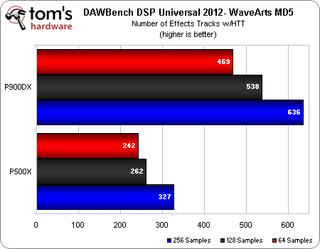iBuyPower P500X And P900DX Workstations, Reviewed
Armed with updated workstation benchmarks, we have two systems from iBuyPower in the lab today: a $2,000 quad-core entry-level rig, and an $8,000 sixteen-core behemoth. With $6,000 separating the two, is the performance spread really what you'd expect?
Digital Audio Workstation Performance
Believe it or not, some folks actually like to do audio stuff on workstations. They would probably be using a much less expensive graphics card, but they occasionally do get to use workstation-class systems for this purpose. As with our previous DAW tests, Echo Digital Audio provided us with an AudioFire 2 for testing.
DAWBench DSP Universal 2012
DAWBench is an effort to provide a reasonably universal cross-platform test of digital audio workstation performance. We're using the version based around REAPER and WaveArts MultiDynamics 5. It measures DAW performance by playing four stereo audio files while multiple iterations of a plug-in (in this case, WaveArts MD5) are added. This continues until the system’s capability to render audio accurately is overwhelmed (in other words, until it breaks up and starts to crackle). The recorded score is the last iteration that can be added before the audio breaks up.
Processor clock rate, the number of cores, memory speed, and overall system latency, along with the performance of the audio interface and its drivers can all affect a systems performance in this test.

We really can't overstate how incredible the P900DX's performance is in this test. Even though its performance hovers around twice that of the P500X, it's still capable of an immense number of effects iterations in REAPER (almost 200 higher than the Boxx 4860 we tested previously). This is a fantastic result for a general workstation that has not been optimized for use as a DAW.
Tom’s Score
Tom's Score is a little musical piece we wrote in the style of TV and film scores. It uses several audio tracks (the drums come off of audio tracks) plus software synthesizers (both virtual analog and sample-based synths) to create a DAW test load. This is more of a pure CPU test because it benchmarks the amount of time required to mix the entire piece down to a stereo audio file in both 44.1 and 192 kHz. If you're interested in hearing what the piece sounds like, it can be found on the author's Soundcloud page.
Stay on the Cutting Edge
Join the experts who read Tom's Hardware for the inside track on enthusiast PC tech news — and have for over 25 years. We'll send breaking news and in-depth reviews of CPUs, GPUs, AI, maker hardware and more straight to your inbox.

At 44.1 kHz, the P900DX comes in about 90% faster than the P500X. At 192 kHz, it finishes 58.8% faster. On both scores, the P900DX is possibly running into storage limitations from trying to play the audio files at the same time (requiring both drive speed and random access speed; this test was performed on each machine's hard drive, not its SSD).
Thesycon DPCLat
The DPC Latency Checker (DPCLat) by Thesycon is a generic test of overall system latency. This test was requested by some readers who are particularly interested in DAW Performance.

In this case, the P500X shows slightly better results. The average for both tended to be around 100 microseconds, peaking at 130 for the P500X and 136 for the P900DX. In this test, anything under 500 microseconds is considered good.
Current page: Digital Audio Workstation Performance
Prev Page Rendering And 3D Animation: VUE, Blender, And SPECviewperf Next Page Encoding: HandBrake And LAME-
sprucegroose The P900DX would be about $6500 for the parts alone. It also comes with warranty, and if you are the type of person using it, the time building it and repairing it might offset the price difference. On the other hand, you could put in better components for the same price.Reply -
manitoublack We've got the Quadro 4000's at work and they're junk. GTX280 is faster and they were released in 2008. I pulled mine and installed my old GTX295, made a huge difference using the mine modelling software.Reply
Quadrao 4000 was all stutters, GTX 295 is buttery smooth. -
csf60 manitoublackWe've got the Quadro 4000's at work and they're junk. GTX280 is faster and they were released in 2008. I pulled mine and installed my old GTX295, made a huge difference using the mine modelling software.Quadrao 4000 was all stutters, GTX 295 is buttery smooth. that's because workstation cards are not meant to be fast at rendering frames. They are fast at doing many simple batch calculations like ray tracing, fluid movement or video editing.Reply -
j2j663 manitoublackWe've got the Quadro 4000's at work and they're junk. GTX280 is faster and they were released in 2008. I pulled mine and installed my old GTX295, made a huge difference using the mine modelling software.Quadrao 4000 was all stutters, GTX 295 is buttery smooth.Reply
This is like someone complaining that a screwdriver is really bad at pounding in nails. Learn to use the right tools for the job at hand. -
I'm curious about the After Effects performance. What were your memory settings when rendering multiple frames simultaneously?Reply
-
Draven35 they varied, I had to set them between 3gb and the minimum in order to the the maximum number of cores. I have a working theory on the AE problem that i will test next opportunity.Reply -
Wow, odd. Anywhere I could get an update on your progress once you test your hypothesis? I'd love to figure out what is causing that result. It should be destroying that benchmark.Reply
Most Popular

